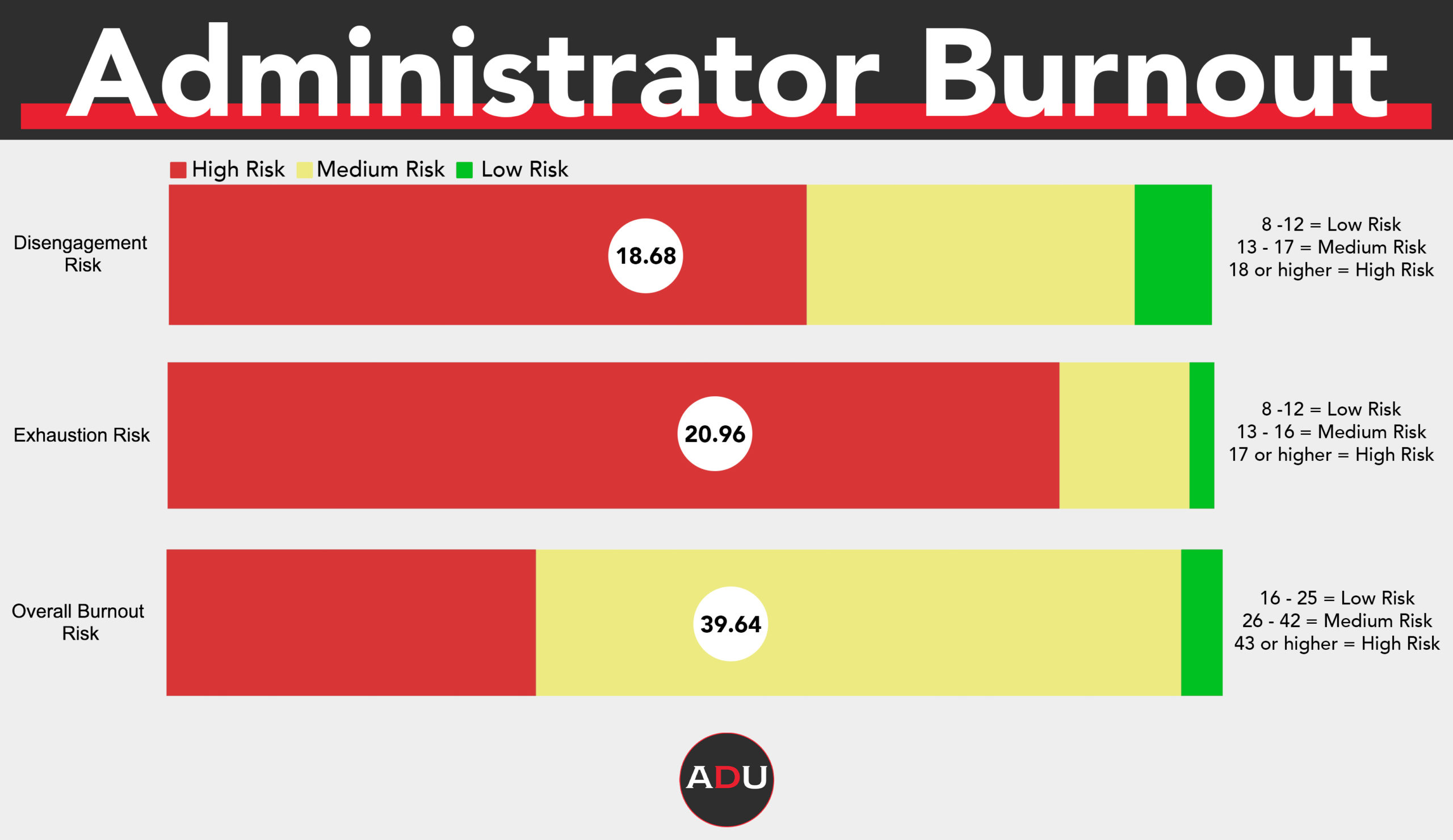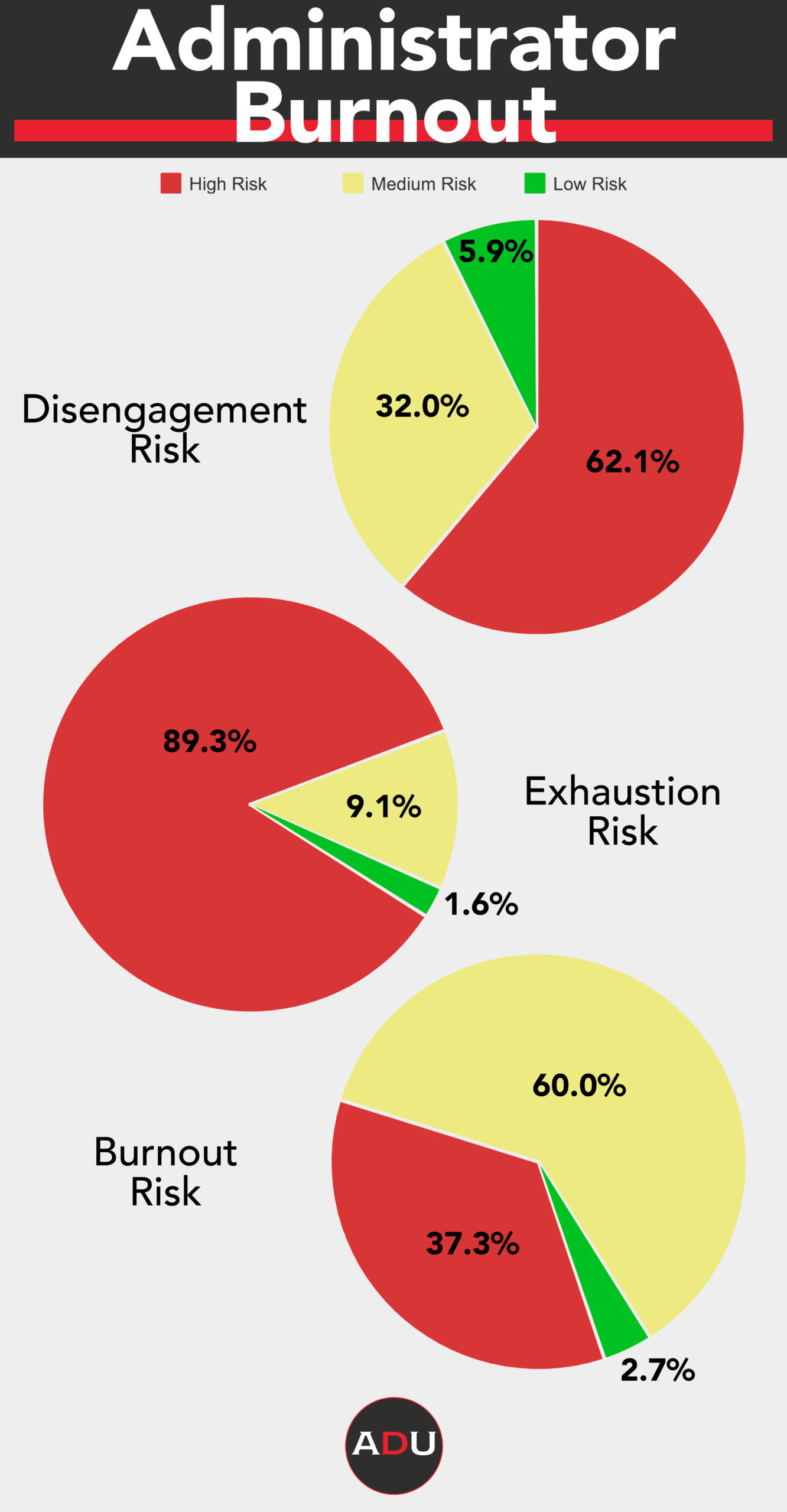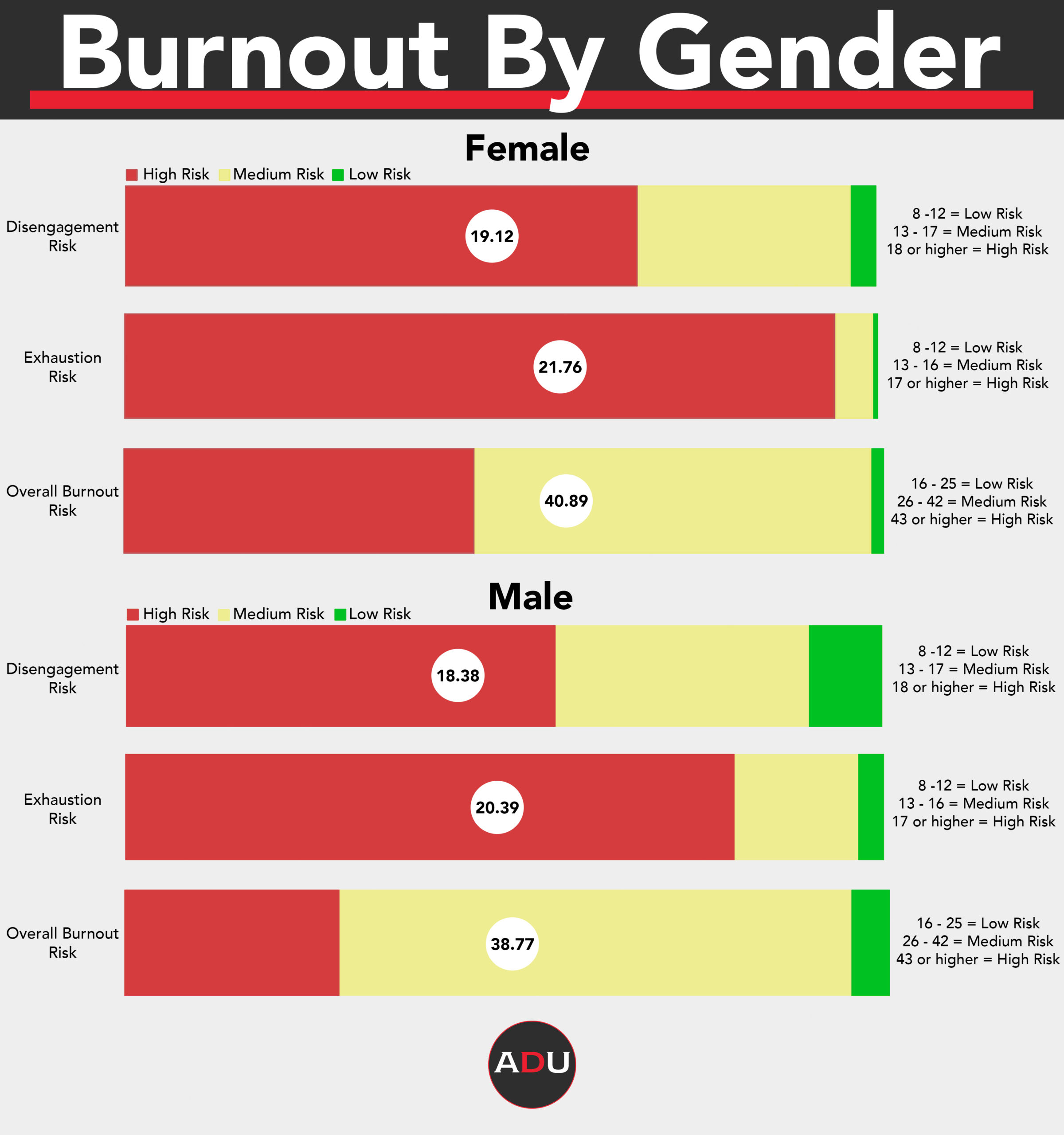AthleticDirectorU, Athlete Viewpoint and Game Plan surveyed thousands of college athletics administrators across the nation in the spring of 2022 for their views on professional burnout, exhaustion and disengagement using the publicly available Oldenburg Burnout Inventory. Read Parts I and II of AthleticDirectorU’s survey on administrative burnout, exhaustion & disengagement here and here. The full Division I survey results can be viewed here.
—–
For Part III of our burnout, exhaustion and disengagement survey, we surveyed thousands of administrators across the Division II and Division III landscape that garnered results similar to their Division I peers. The Division II and III survey results can be viewed here. Comparatively, small college administrators were at a slightly greater risk of burnout and exhaustion, with a marginally lower risk of disengagement.

Diving deeper into the data shows an overwhelming majority of administrators are at high risk of exhaustion and disengagement.

Separating the responses by gender, female respondents comprise a larger proportion of administrators with a higher level of risk for disengagement, exhaustion and burnout.

As the data illustrates, the burnout, exhaustion and disengagement risks are just as prevalent as their Division I peers. Now, let’s examine administrators’ comments on the factors contributing to burnout.
In exploring responses, the growing workload for administrators came back as the most common cause of burnout, with a lack of proper staffing and resources coming in second. Additional causes cited include compensation and financial pressures, administration/management, loss of purpose, the ever-changing landscape of college athletics, COVID and more. Upon further analysis, responses fall into three categories: Resources, Leadership and Industry-wide Issues. All comments were submitted anonymously.
RESOURCES
“The one thing I have noticed in the last few years is I am not getting the same amount of work completed in the same amount of time. I cannot quite put my finger on why this is exactly. I am not sure if it is because of turnover in the department, more tasks being added to my plate, having to help and retrain coaches on the same tasks or general lack of engagement on my part. I do know that when I leave the athletics facility I do not want to be contacted for work again until the next day.”
“As a commissioner, there are so many factors outside of my control that impact my job and success at it. That can be very mentally and physically draining. It seems everyone has a better idea or way that this job can be done and most have no idea the pressures of managing hundreds of coaches and staff at member institutions, multiple championships, 7,000 student-athletes, hundreds of officials, etc. The time demands are the biggest factor. Today’s favor becomes tomorrow’s expectation, so the daily tasks become more and more on a consistent basis. There is very little time off even in the summer or over the winter break.”
“At my DIII college I am the only athletic trainer for 10 teams. It has been a lot of work both in the normal capacity of a clinical athletic trainer, administrative duties, and dealing with the emotional drainage that comes with the mental health and daily life struggles that the athletes face and share with me. I have used the NATA data and equation to state a case as to why there needs to be another assistant working, however, my school has not seemed promising in providing an assistant anytime in the near future, and I am sadly leaving my position because the work I have been doing is not sustainable long-term.”
“I feel more and more as if I can’t think; this includes taking longer to come up with the right words and finding less energy to handle challenges. Over the last year and a half I’ve found that I can only sleep the necessary amount of hours each night on the days I don’t have to go into work the following day. My health and personal relationships have been sacrificed in order for me to continue to do this job over the last couple of years. Institutions and the industry as a whole need to consider making serious changes to expectations and the time required for all athletics personnel.”
“As with many DIII schools we face resource challenges both physical and human. As a department we do not have enough human capital to compete with other institutions that are much more well-funded. As a result we burn through coaches and staff very quickly. There seems to be no ‘alarm’ to the amount of staffing turnover we face…the school administration simply shrugs their shoulders. In addition the salaries are not at a level where the coaches can ‘pay’ to have things done to open up some free time. For example, non of my co-workers have a house cleaner, or someone who cuts their grass, etc.”
LEADERSHIP
“Since starting my new role in early May 2022, I have a new sense of purpose and am driven to achieve. My major concerns are lack of institutional direction, no on-boarding process, and the expectation to know what to do when within my school. I have also heard ‘do whatever you want’ more times than I can count. This is beyond frustrating.”
INDUSTRY-WIDE ISSUES
“… DIII is not DI, yet we’ve had to inherit a lot of DI’s problems. The NCAA needs a leader who values DIII and will provide us the necessary resources to succeed. Yet, the NCAA wants to continue to absolve itself from any responsibility and legal liability for everything. Bat testing and the way it mysteriously became a requirement for DIII put unneeded pressure on small staffs. The NCAA administrators refuse to make changes, perhaps for self-preservation, and it’s killing its membership. Talent is leaving because they’re burnt out. The loudest voices get to shape everything. Membership survey questions should be coming from the membership, yet the NCAA continues to lead people to answers they want. In addition, they need to stop announcing NCAA Championship balls and equipment because distributors are jacking up their prices. Maybe the NCAA can purchase these items because they have the leverage to keep items more affordable for the membership. Corporate greed is hurting business, including DIII.”
“Coaches act more like children than our student athletes do nowadays. Plus the NCAA has no control/governance over things anymore, particularly the ‘Power 5.’ Which in turn makes an AD job harder, because the lack of leadership and confidence is non-existent isn’t there in our governing body.”
“The demands of the NCAA having the student-athletes practice and compete much longer during their season and off-season has created a significant amount of increased injuries as well as mental and emotional strain for many student-athletes. I cannot blame my institution for the burnout any more than society itself putting the coaches and athletes of all levels in a predicament to perform close to year-round without creating all the stress and strain on all of us physically, mentally, emotionally, as well as spiritually. I am very passionate about my career choice and would hate to leave but over time it has become quite difficult to manage the amount of injuries to care for.”

